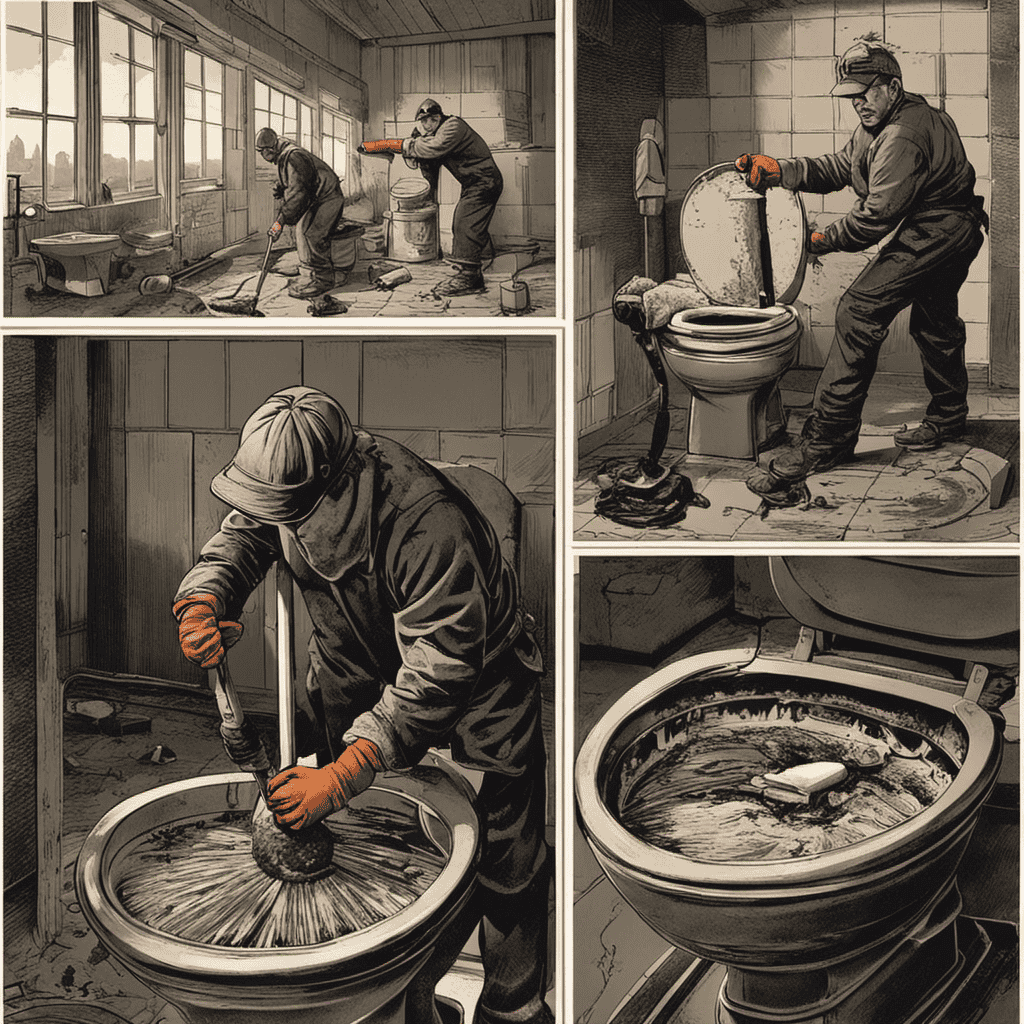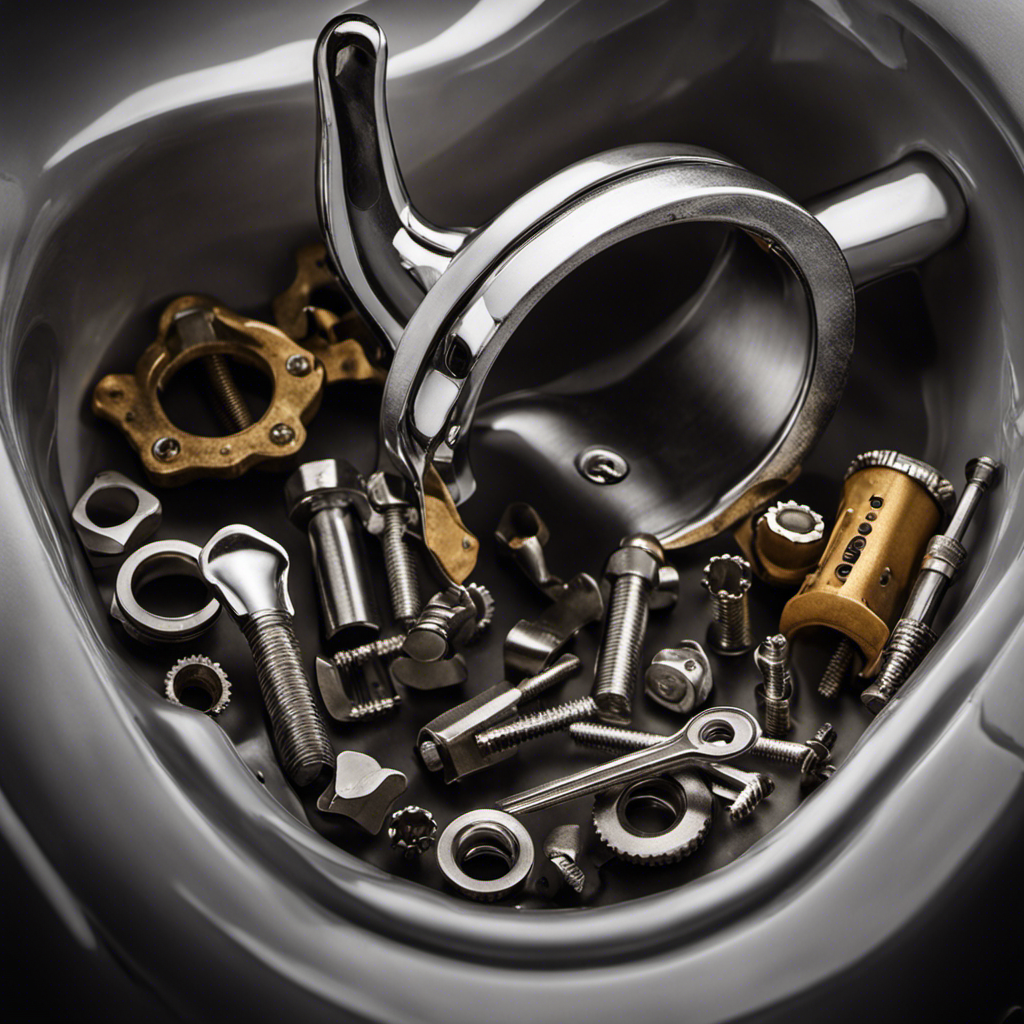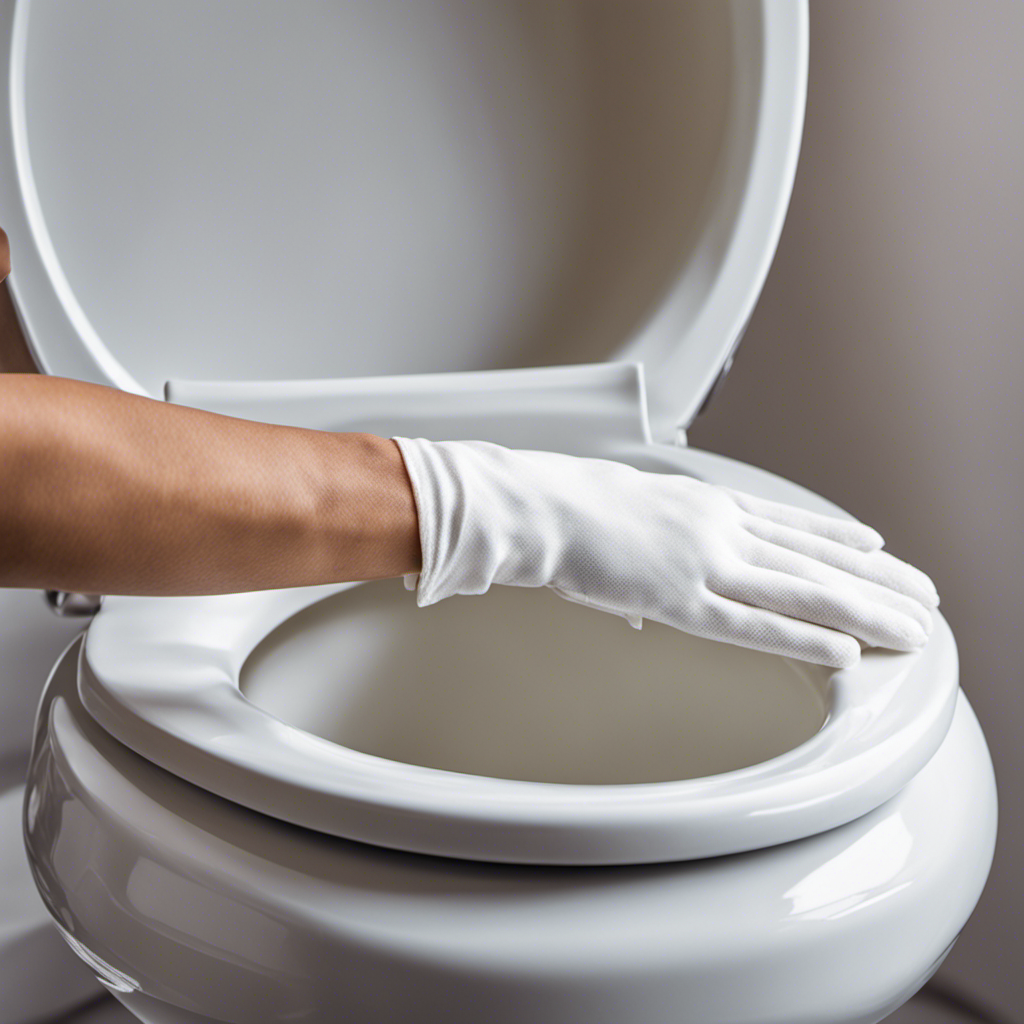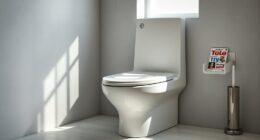I’m no stranger to the messy business of toilet clogs, and let me tell you, plunging a toilet with poop is a challenge like no other.
But fear not, because I’ve got the know-how to tackle this smelly situation head-on.
In this article, I’ll guide you through the steps to understanding the problem, gathering the necessary tools, and executing the proper plunging technique.
Together, we’ll conquer those stubborn clogs and keep your toilet flowing smoothly.
So grab your plunger and let’s dive in!
Key Takeaways
- Identify the cause of the clog (excessive toilet paper, foreign objects, waste buildup)
- Choose the right type of plunger for the job
- Flush the toilet to clear excess water before plunging
- Use a plunger designed for toilets with a flange to create a tight seal
Understanding the Problem
You’ll want to understand the problem before attempting to plunge the toilet with poop. When faced with a clogged toilet, it is crucial to identify the cause of the blockage. Common causes include excessive toilet paper usage, foreign objects, or a buildup of waste material. Understanding the cause will help determine the best approach to unclogging the toilet.
Once the cause is identified, it’s time to consider potential solutions. One option is using a plunger, which creates suction to dislodge the blockage. Another solution is using a toilet auger, a tool specifically designed to remove stubborn clogs. In severe cases, professional plumbing assistance may be required.
Gathering the Necessary Tools
When it comes to plunging a toilet, having the right equipment is essential. The key to a successful plunge is proper tool selection, which means using the right type of plunger for the job.
In addition to the plunger, there are a few must-have supplies that will make the plunging process easier and more effective.
Essential Plunging Equipment
To effectively plunge a toilet with poop, make sure you have all the essential equipment. Here are the key items you’ll need:
-
A sturdy plunger: Make sure it has a good seal and is in good condition. Regular plunger maintenance, such as cleaning and checking for any damage, is crucial for effective plunging.
-
Rubber gloves: Protect your hands from any mess and bacteria.
-
Cleaning solution: Use a disinfectant cleaner to sanitize the area after plunging.
-
Old towels or rags: These can be handy to clean up any spills or to protect the floor.
-
Plastic bag: Have a bag ready to dispose of any waste or soiled materials.
Having these essential tools will ensure that you are well-prepared to tackle the job at hand.
Now, let’s move on to the next section and discuss the proper tool selection to maximize your plunging success.
Proper Tool Selection
The key to selecting the right tools for effective plunging is ensuring they are sturdy and in good condition. When it comes to toilet maintenance and unclogging techniques, having the proper tools is essential.
A sturdy plunger with a rubber head is a must-have for any homeowner. It creates a tight seal around the drain, allowing for maximum pressure and suction. Make sure the rubber head is in good condition, free from cracks or tears that could hinder its effectiveness.
Additionally, consider using a toilet auger for more stubborn clogs. This tool has a long, flexible cable that can reach deeper into the pipes to break up the blockage.
Must-Have Supplies
Ensure you have all the necessary supplies for effective unclogging, such as a sturdy plunger and a toilet auger. These tools are essential for dealing with stubborn clogs and maintaining the functionality of your plunger.
Here are some key points to keep in mind:
-
Regular plunger maintenance: After each use, rinse the plunger with hot water and a disinfectant to remove any bacteria or residue. Store it in a clean and dry area to prevent mold or mildew growth.
-
Alternative methods: If you don’t have a plunger on hand, you can try using a wire hanger or a combination of baking soda and vinegar to break up the clog. However, these methods may not be as effective as using a plunger or toilet auger.
Preparing the Toilet for Plunging
Flush the toilet to clear out any excess water before plunging. This is an important step in toilet maintenance and unclogging techniques. By flushing the toilet first, you ensure that there is enough space for the plunger to work effectively. Excess water can hinder the plunging process and make it more difficult to clear the clog.
Once you have flushed, the next step is to prepare the toilet for plunging. Make sure you have a plunger that is specifically designed for toilets, with a flange at the bottom to create a tight seal. Position the plunger over the drain hole in the toilet bowl and apply firm, downward pressure. This will create suction and help dislodge the clog. Repeat this motion several times until the water starts to drain.
Proper Plunging Technique
When it comes to plunging a toilet effectively, there are a few key points to keep in mind.
First, make sure that the plunger is in the correct position, with the rubber cup fully covering the drain hole.
Second, apply adequate pressure by pushing down firmly and forcefully, using your body weight if necessary.
And finally, be mindful of avoiding a splashing mess by keeping the plunger submerged in water at all times and using controlled plunging motions.
Correct Plunger Position
Make sure the plunger is firmly pressed against the bottom of the toilet bowl. This is the correct plunger technique to effectively unclog a toilet.
When plunging, avoid these common mistakes:
-
Placing the plunger at an angle: Ensure that the plunger is straight and perpendicular to the bowl. This allows for a proper seal and maximum force.
-
Lifting the plunger too quickly: Gently push down on the plunger, then pull up slowly. Rapid movements can break the seal and reduce the effectiveness of the plunge.
-
Using too much force: Apply firm pressure, but avoid excessive force. Pushing too hard can damage the toilet or cause water to splash out.
-
Not using enough water: Add some water to the bowl before plunging. The water helps create suction and aids in dislodging the clog.
-
Neglecting to clean the plunger: After each use, clean the plunger thoroughly to prevent the spread of bacteria.
Applying Adequate Pressure
Applying enough pressure is crucial when using a plunger to effectively unclog a toilet. To ensure success, it is essential to employ adequate pressure techniques and troubleshoot common issues that may arise during the process.
Firstly, when plunging a toilet, it is important to position the plunger correctly. Place the rubber cup of the plunger over the drain hole, ensuring a tight seal. This will maximize the pressure applied to dislodge the clog.
Next, apply downward pressure on the plunger handle while keeping a firm grip. Use a vigorous, up-and-down motion to create suction and force water through the drain. This technique helps break up the blockage and clear the pipe.
If the clog persists, try adjusting the angle of the plunger or adding more water to increase the pressure. Additionally, be cautious not to overflow the toilet bowl when plunging vigorously.
Avoiding Splashing Mess
To avoid making a mess, remember to keep a tight grip on the plunger handle and use steady, controlled motions. Plunging a toilet with poop can be a messy task, but with the right technique, you can minimize splashing and keep things clean. Here are some tips to help you avoid creating a mess:
- Position the plunger correctly over the drain to create a good seal.
- Push down firmly, but not too forcefully, to create suction.
- Use an up-and-down motion, keeping the plunger submerged in water at all times.
- Maintain a steady rhythm and pace to prevent splashing.
- If you notice water rising towards the rim, pause and release pressure to avoid overflow.
Dealing With Persistent Clogs
If you’ve tried everything but the clog is still persistent, it might be time to consider using a plunger. Dealing with stubborn clogs can be frustrating, but with the right techniques, you can unclog your toilet effectively.
First, make sure you have a good quality plunger with a flange at the end. This will create a better seal and increase the chances of success.
Next, position the plunger over the drain hole and firmly push down, creating a tight seal. Then, rapidly plunge up and down, using force to dislodge the clog. Be persistent and keep plunging until the water starts to drain.
Preventing Future Toilet Clogs
After dealing with persistent clogs, it’s important to take steps to prevent future blockages and maintain toilet hygiene. Here are some effective tips:
- Use less toilet paper: Reducing the amount of toilet paper used can help prevent clogs.
- Flush only appropriate items: Avoid flushing anything other than toilet paper and bodily waste down the toilet.
- Install a toilet paper holder: This can prevent excessive amounts of toilet paper from being used.
- Regularly clean the toilet bowl: A clean toilet bowl reduces the chances of buildup and blockages.
- Schedule professional plumbing maintenance: Regular inspections and maintenance by a professional plumber can help identify and address any potential issues before they become major problems.
Additional Tips and Considerations
Don’t forget to regularly check the water pressure in your home to ensure it’s not too high, as this can contribute to clogs in the toilet.
In addition to this important step, there are other alternatives to plunging a toilet and ways to prevent clogs from occurring in the first place.
One alternative to plunging is using a toilet auger or snake. This tool is designed to reach deep into the pipes and break apart any clogs.
Another option is using a toilet drain cleaner, which can help dissolve any buildup that may be causing the clog.
To prevent future toilet clogs, it’s important to only flush toilet paper and waste, avoiding the flushing of items like paper towels, feminine hygiene products, or excessive toilet paper.
Regular maintenance, such as cleaning the toilet and inspecting the flapper valve, can also help prevent clogs.
Conclusion
In conclusion, plunging a toilet with poop can be a daunting and messy task, but fear not!
With the right tools and technique, you can conquer even the most stubborn clogs.
Remember, a plunger is your trusty sidekick in this battle against the forces of nature.
Don’t be afraid to apply a little elbow grease and give it your all.
And when you finally emerge victorious, the feeling of triumph will be sweeter than you can ever imagine.
So go forth, fearless warriors of the porcelain throne, and plunge away!










